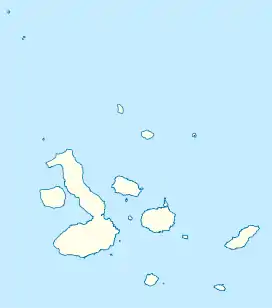| Cerro Pajas | |
|---|---|
 | |
| Highest point | |
| Elevation | 640 m (2,100 ft) |
| Prominence | 359 m (1,178 ft) |
| Listing | Ultra |
| Coordinates | 1°17′37″S 90°27′26″W / 1.29361°S 90.45722°W |
| Geography | |
 Cerro Pajas Galápagos Islands | |
| Location | Floreana Island, Galápagos Islands, Ecuador |
Cerro Pajas (also known as Cerro Paja or Cerro de pajas[1]) is an inactive volcano located in the south of Floreana Island in the Galápagos Islands, Ecuador. It is the highest peak on Floreana, with a maximum elevation of 640 meters above sea level.[1][2][3][upper-alpha 1]
Wildlife
The area around the Cerro Pajas crater contains the largest expanse of highland Scalesia pedunculata forest on the island, providing important habitat for multiple species of Darwin's finches, including the critically endangered medium tree finch.[5]
Petrel colony
Cerro Pajas hosts the island's most important colony of Galapagos petrels.[6] In 1981, it was estimated that the petrel colony, comprising about 2000 breeding pairs, was declining by 33% every year, due to predation by black rats, cats and other introduced species.[7] The colony is also threatened by introduced plants, such as Lantana camara L., which was introduced to the island in 1938.[8] In 1982, the World Wildlife Fund funded a five-year conservation programme to control rats, cats, pigs, goats and donkeys at the colony.[7]
Prior to 1984, the residents of Floreana had declared Cerro Pajas a "Protected Area", an initiative led by local conservationist Felipe Cruz.[6] In the early 1980s, conservationists launched the first programme to control introduced rats at Cerro Pajas, to improve the petrels' breeding success.[6] This programme was started by Malcolm Coulter, an ornithologist at the Charles Darwin Research Station, and continued in its early years by Felipe Cruz and American naturalist Tina Beach.[6] In 1983, the first year in which rats were controlled, the petrels' overall nesting success rose from 31% to 46%, despite high rainfall that collapsed many of the petrels' burrows.[6][7] The following year, breeding success improved even more, with 72 chicks fledged across 100 nests.[7][9] Targeted hunting of cats, goats, donkeys and pigs also reduced disturbance of petrel nests.[7] Throughout the 1980s, continued rat baiting allowed the petrel colony to maintain high levels of nesting success.[7]
Gallery
 Scalesia forest inside the Cerro Pajas crater.
Scalesia forest inside the Cerro Pajas crater. Looking down on Cerro Pajas crater.
Looking down on Cerro Pajas crater. Galapagos petrel nesting under a boulder at Cerro Pajas.
Galapagos petrel nesting under a boulder at Cerro Pajas.
See also
References
Notes
Citations
- 1 2 David William Steadman (1982) "Fossil birds, reptiles, and mammals from Isla Floreana, Galapagos Archipelago", PhD thesis, University of Arizona.
- ↑ "Floreana", Galapagos Conservancy. Accessed March 22, 2020.
- ↑ Michael Dvorak, Erwin Nemeth, Beate Wendelin, Patricio Herrera, Denis Mosquera, David Anchundia, Christian Sevilla, Sabine Tebbich & Birgit Fessl (2017). "Conservation status of landbirds on Floreana: the smallest inhabited Galápagos Island". Journal of Field Ornithology, 88(2): 132-145.
- ↑ Simbana, W., & Tye, A. (2009). "Reproductive biology and responses to threats and protection measures of the total population of a critically endangered Galapagos plant, Linum cratericola (Linaceae)". Botanical journal of the Linnean Society, 161(1): 89-102.
- 1 2 Jody A. O'Connor, Frank J. Sulloway & Sonia Kleindorfer (2010) "Avian population survey in the Floreana highlands: is Darwin’s Medium Tree Finch declining in remnant patches of Scalesia forest?" Bird Conservation International, 20(4): 343-353.
- 1 2 3 4 5 Duffy, David (1984) "The endangered petrel of the Galapagos volcanoes." Noticias de Galapagos, 39: 24-27.
- 1 2 3 4 5 6 Cruz, Justine B., and Felipe Cruz (1996). "Conservation of the dark-rumped petrel Pterodroma phaeopygia of the Galápagos Islands, 1982–1991". Bird Conservation International, 6(1): 23-32.
- ↑ Felipe Cruz, Justine Cruz & Jonas E. Lawesson (1986). "Lantana camara L., a threat to native plants and animals." Noticias de Galápagos, 43: 10-11.
- ↑ Felipe Cruz, Justine Cruz, Jaime Astudillo & Hugo Sanchez (1984) "Protecting the Hawaiian petrel." Noticias de Galapagos, 40: 8.